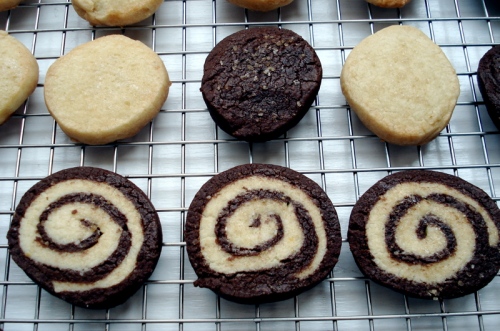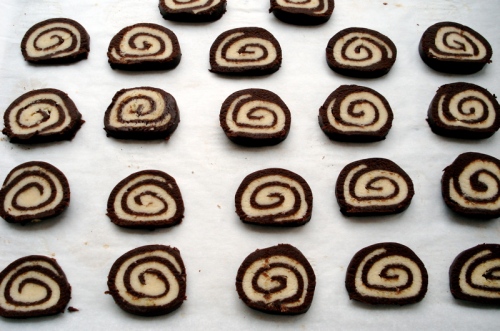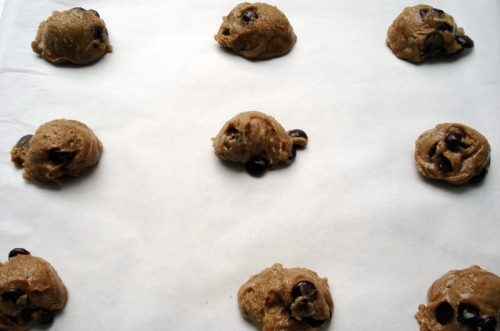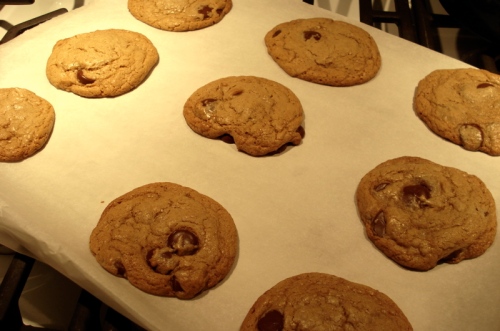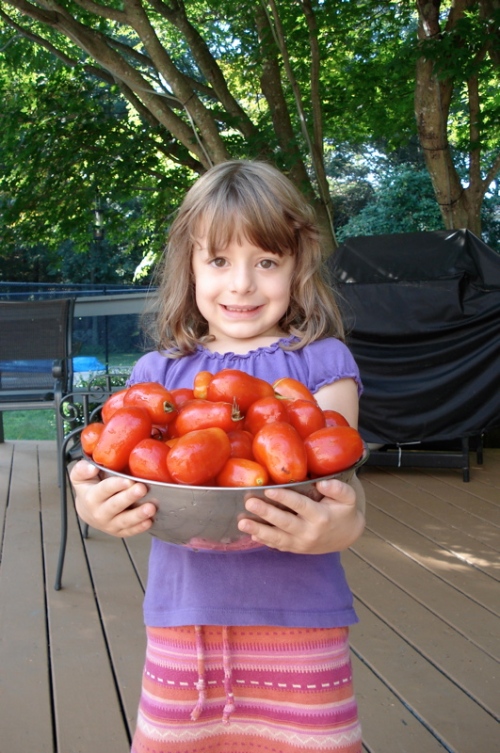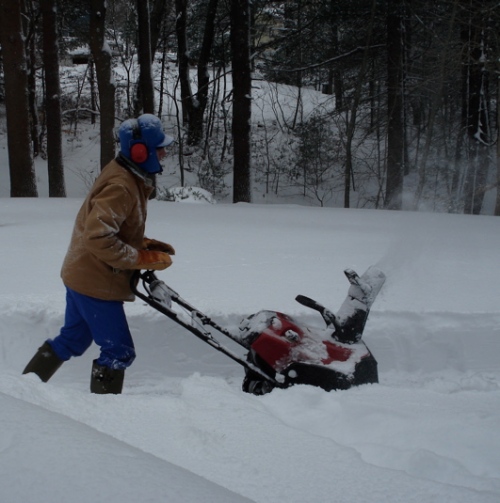
When I went to school in Burlington, there was a restaurant down the road in Shelburne called the Sirloin Saloon*. It was a steakhouse, and had a salad bar and good steak tips, but to me, the outstanding thing was their bread. It was dark and sweet and hearty. They served it warm, and it was so good that they offered it sold as loaves to take home. Seen whole, the loaves were big and round and rustic looking. I think this was unusual for the mid-eighties.
I was remembering that bread a few years ago and wanted to make my own, but couldn’t find any recipe leads on-line. I called the restaurant and spoke with someone in the kitchen. This is how I remember the conversation going:
Me: Hi. I had your bread a number of years ago and really loved it. I’ve since moved away and was wondering if you give out the recipe?
Him: No.
Me: Oh. Well, if you don’t give the recipe, do you give hints?
Him: Maybe. Ask me.
Me. Ok. I remember it being dark and sweet. Do you use molasses for the sweetener?
Him: Yeah. We use one to one to a half…dark molasses, light molasses and honey.
Me: (frantically scribbling): I think it’s whole grain. Do you use any rye flour?
Him: No. We use high gluten white and rye flakes.
Me: Rye flakes? What are rye flakes?
Him: Like oatmeal. Only rye.
Me: Huh. Rye flakes. Is there any caraway or anise in it?
Him: No. It’s a pretty standard loaf. Listen, I gotta go.
Me: Ok, thanks a lot…love your (click) bread.
From these hints pulled from a laconic chef, I was able to reproduce, at least to my taste buds and memory, the Sirloin Saloon bread. Here’s how I did it (the full recipe is at the end of this post).
1. He said it was a “pretty standard loaf”.
I know from baker’s percentages that a standard dough is about 55-70% hydration, 2% salt, 1% yeast, and 8-16% sweetener. For a Swedish limpa, the sweetener is 20% and for a Portuguese loaf is 22%. I didn’t remember the bread being as sweet as Portuguese bread, so I decided to try 20%. This information gave me a good start on the broad strokes of the recipe.
2. The mysterious rye flakes

I had never heard of rye flakes, so I did an on-line search and found that they can be bought at beer brewing supply stores. I went to my local brew store and got a two-pound bag. The look a lot like old-fashioned oats, except they are firmer and darker. In other recipes using oats in bread, you are told to soak them in hot water before combining them with the other ingredients so I decided to do the same thing with the rye flakes.
3. He uses high gluten flour.
I don’t use high gluten (or bread flour), but I know it is 13.7% protein. My King Arthur all-purpose flour is 11.7% protein. I happened to have on hand (who remembers why) some vital wheat gluten. So after doing some math, I found that if I added 3 grams of vital wheat gluten to every 100 grams of all-purpose flour, I could bring up the protein to 13.7%.
In the interest of full disclosure, I forgot to add the wheat gluten to my flour when making the recipe for this post! It came out just fine, so I guess you can also use plain, old, all-purpose flour.
4: A ratio of 1:1:0.5 dark molasses: molasses: honey
I had regular (unsulphered Grandmother’s) molasses but never heard of dark molasses. I again went on-line, but the only other type of molasses I could find was blackstrap molasses. I got this at the grocery store. It has a very different taste than regular molasses, stronger and less sweet. It reminds me of black licorice. So equal amounts of dark and light molasses, and half the amount of honey.
The recipe:
I knew from my honey oat bread, that 710 gm flour plus 114 gm oats makes dough enough for 2 loaves, so that is where I started:
My Sirloin Saloon Bread Recipe
I made my own high protein bread flour by combining 800 gm all-purpose flour plus 25 gm vital wheat gluten. Just buy bread flour, it’s easier. (I used all-purpose flour on this batch, and it was fine.)
Combine:
114 gm (1 c) rye flakes
236 gm (1 c) boiling water
Let this soak until softened and cooled to about 110 degrees.
Add to softened rye:
710 gm (about 6.25 c) all-purpose flour
322 gm (1 1/3 c) milk, warmed to 110 degrees
The dough at this stage will look dry.

Combine and add to dough:
66 gm (3T) light molasses
66 gm (3T) blackstrap molasses
33 gm (1.5 T) honey
16 gm (5t) kosher salt
18 gm (1T) butter, melted
Finally add:
8 gm (1 pkg or 2 ¼ t) active dry yeast
Begin to mix the dough in earnest. At this point it will be really sticky.

Knead dough in Kitchen Aid mixer until smooth (about 7-10 minutes). I’ve never tried kneading this by hand, it starts out pretty sticky.

My advice would be if you want to knead it by hand, prepare to get messy and use a light hand when flouring the counter.
Through the magic of kneading, it will turn into a smooth, slightly tacky dough.

Place the dough in a container, cover and let rise until double (about an hour).

Behold! It has risen!

I ease it out of the dough bucket, knead it a couple of times and divide it in half. I decide to make a loaf and a boule. I spray the loaf pan with Pam, shape the loaf and place it in the pan. For the boule, I round it into a ball shape, and using my hands and the counter, I tuck the sides of the boule under, stretching the surface of the dough tight.

I place the boule, seam side down on a floured cloth, and place it in a bowl to help it rise more up than out for this final rise.

I let the bread rise about 1.5 times (about an hour).

At the start of the final rise, I preheat the oven with a baking stone to 350 degrees. It takes extra preheating time to get the stone nice and hot. The only reason I’m using a stone is because I am baking a free-form loaf. I slash the loaves…

and bake on the baking stone for 35-40 minutes. In the above picture, I’ve put a little cornmeal on a baking sheet to serve as a peel to slide the boule onto the stone. I don’t bake either of the loaves on a baking sheet.

The bread came out very good. Hearty and sweet, with a little crunch on the crust. The interior has a fairly tight, but soft crumb.

If I were going to tweak this recipe a bit more, I think I would try adding some whole wheat or rye flour to make it a little more hearty and not so soft. Also, if I were baking only rustic loaves (ie. not in a pan) I would up the temperature to 400 degrees and maybe introduce a little steam at the start to make the crust darker and crustier. All in all, I think this recipe is a very good approximation of the Sirloin Saloon bread I remember from the 1980’s..
My Take: Sirloin Saloon Bread
114 gm (1 c) rye flakes
236 gm (1 c) boiling water
Combine and let this soak until softened and cooled to about 110 degrees.
Add to softened rye:
710 gm (about 6.25 c) all-purpose flour (or bread flour)
322 gm (1 1/3 c) milk, warmed to 110 degrees
Combine and add to dough:
66 gm (3T) light molasses
66 gm (3T) blackstrap molasses
33 gm (1.5 T) honey
16 gm (5t) kosher salt
18 gm (1T) butter, melted
Finally sprinkle on top:
8 gm (1 pkg or 2 ¼ t) active dry yeast
Mix dough to combine, and then knead by machine until smooth, but still tacky (about 7-10 minutes). Set dough aside to rise until doubled, about 40-60 minutes. Knead dough a couple of times, divide in half and shape. If making loaves, spray pan with cooking spray. Set dough aside to rise about 1.5 times (about 45-60 minutes). Preheat oven to 350 degrees during this final rise. If making free-form loaves (not in a pan) bake on a baking stone, so make sure this is well pre-heated. Bake bread for about 35-40 minutes.
*I just found that the Shelburne location has closed but it has locations in Rutland and Manchester

